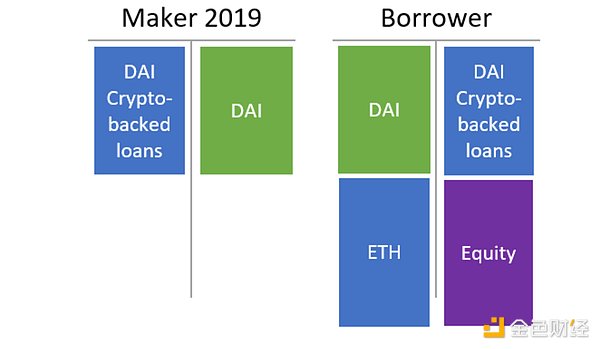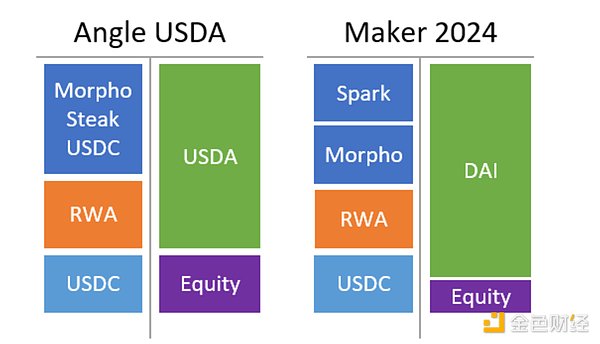Author: seb Source: cryptobanking Translation: Shan Ouba, Golden Finance
DeFi stablecoin issuers have long had a symbiotic relationship with lending activities. In this article, we explored the intrinsic connection between lending protocols and stablecoin issuers. Not only do stablecoins originate from lending protocols, but lending protocols themselves can also be seen as a type of stablecoin issuer. In addition, there is a growing trend to delegate the lending function of stablecoin issuers to specialized lending protocols. Finally, we have a preliminary discussion on the types of stablecoins that stablecoin issuers should lend.
Stablecoins started out as lending protocols
What was MakerDAO originally? If not a lending protocol designed to borrow DAI (stablecoin) with ETH as collateral?
Let's take a step back and start with some formalization (see Accounting Primer for more on this). We define a stablecoin issuer as an entity with a balance sheet that issues stablecoins as liabilities and promises to keep them around par value (relative to the U.S. dollar). DAI also promises to be redeemable during emergency shutdowns. For more information on DAI stability, see the article "The History of Par DAI".
To keep the balance sheet in balance, issuing a stablecoin requires a corresponding increase in assets, usually in the form of collateral backing the stablecoin. For now, we exclude equity from this discussion, but it is important that a stablecoin issuer cannot have negative equity, i.e. it should not go bankrupt. This increase in assets represents the loan taken by the borrower, which is initially matched to the value of the minted stablecoins. Note that the collateral does not appear on the balance sheet because ownership is not transferred - only control. Over time, assuming the interest rate on the loan, the value of the loan will increase, while the minted stablecoins remain the same. This difference constitutes the profit of the stablecoin issuer.

Lending protocols are stablecoin issuers
Now let’s talk about lending protocols and argue that they are actually a specific type of stablecoin issuer. The key is to recognize that these stablecoins are not marketed as such.
In the figure below, we compare the Maker balance sheet after incorporating PSM (USDC) to the Aave balance sheet limited to the USDC market. Surprisingly, there is no significant difference between the two. Both aUSDC and DAI are redeemable for USDC at par. While all aUSDC gains value through rebasing, only DAI deposited into the DSR accrues interest (even though in theory all DAI should be deposited). Aave issues loans in USDC, while Maker issues loans in DAI.
Stablecoins Externalize the Lending Component
As lending protocols become more professional and mature, stablecoin issuers are beginning to delegate this component to third parties. For example, Angle USDA uses Morpho for its lending component, even though the team developed a cutting-edge lending system themselves. Similarly, Maker now relies primarily on Spark (an Aave v3 clone) and Morpho for its lending needs, replacing the traditional vault system.
There are several reasons for this shift. First, distribution is critical to finding borrowers. Leveraging well-known protocols helps attract borrowers. Second, aggregation can improve liquidity. For example, Angle USDA has invested $15 million in SteakUSDC (Morpho’s lending vault). Combined with other lenders, immediate liquidity is currently $23 million. This means that if there is a bank run on Angle USDA, all investments in SteakUSDC can be unwound in a single block. This is not possible in proprietary lending systems, where the typical solution is to raise interest rates to discourage borrowers (or wait until they are liquidated). Third, the delegated lending feature allows stablecoin issuers to focus on higher-level considerations, primarily asset-liability management.

You can borrow, but which stablecoin
As we have seen, the lending of assets by stablecoin issuers is increasingly outsourced to specialized lending protocols. A key question remains: which stablecoin should be borrowed? Should it be the native stablecoin of the issue (such as DAI or USDA), or a stablecoin used for a stable peg (such as USDC, a higher-level currency in the currency hierarchy)?
The simplest answer is to use the native stablecoin. For some stablecoin issuers (such as Liquity v1), this is the only valid answer. But more broadly, there are two reasons:
The second point is critical. People often mistakenly believe that stablecoin issuers have no capital costs. Misunderstanding this may lead stablecoin issuers to advertise extremely low borrowing costs to incentivize people to use stablecoins. However, since borrowers will typically sell stablecoins, the net effect is reduced revenue (resulting in less yield distributed to organic stablecoin holders). This approach is not recommended.
Nevertheless, borrowing using your own stablecoins can be done at lower interest rates because the unborrowed USDC in the lending protocol will drag down the lender's performance. If there is 10% liquidity in the lending protocol, using your own stablecoins may reduce the borrowing rate by 10%. However, this does not come without a cost. Idle USDC in lending protocols provides a reserve of liquidity that is not available using one’s own stablecoin. Furthermore, using one’s own stablecoin reduces the aggregation benefits discussed in the previous section. Therefore, the optimal strategy remains unclear and the differences are subtle. It should be determined on a case-by-case basis.
In summary, it is important to recognize that lending protocols are a subset of stablecoin issuers. The professionalization of lending protocols and the delegation of lending functionality to these protocols is leading to changes in market structure. We can expect stablecoin issuers to increasingly become the primary lenders on these lending platforms.
 JinseFinance
JinseFinance











